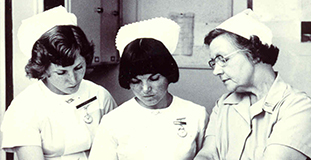The rush for gold in the mid-19th century brought 40,000 people to Bendigo, which led to the creation of a formal health service for the region.
Squalid living conditions and amateur mining techniques fostered disease and serious injury.
Doctors and health professionals were in short supply on the goldfields, but those treating the ill began to push for a proper hospital.
In 1853 a slab and weatherboard building was built on ‘Hospital Hill’, and the Bendigo Gold District General Hospital was born.
The hospital lasted just six years before it switched to a larger site near Arnold Street, where hospital buildings remain today.
Austere times in the 1870s and 1880s slowed down development at the new hospital, which relied heavily on community generosity.

By 1883, 1195 inpatients were admitted, with a daily average of 127. Almost half of the expenditure of the hospital was raised by the local community through events like the Easter Fair and Hospital Sunday, among others.
The Easter Fair was established in 1871 to fundraise for the hospital and the Bendigo Benevolent Asylum.
Over the years, government support for the hospital has strengthened, but fundraising links between the community and the hospital remain.
The Bendigo Health Foundation Charitable Trust, established in 1991, facilitates this link and governs donations totalling around $1 million each year.
The first half of the 20th century saw Bendigo Hospital battle through two depressions, world wars and a wave of infections.
Scarlet fever, diphtheria, polio and a 1919 worldwide influenza epidemic known as ‘the harvest of death’ stretched the hospital’s resources to its limits.
The hospital had expert staff to help it through the turbulent period, none more excellent or eccentric than Matron Martha Farquharson, who was often seen with a cockatoo perched on her wrist as she undertook her rounds.
Matron Farquharson was known for her personal kindness and care toward young nurses and patients, and an annual award for nursing excellence at the Bendigo Hospital is bestowed in her name.

The 1960s was a decade of significant clinical growth for Bendigo Health. A $1.5 million redevelopment of the hospital precinct began in 1962.
A three-bed ICU unit, pathology lab, new casualty and outpatients department were additions to a hospital which by 1975 had 37 honorary medical staff and 15 salaried medical officers.
Extra services brought increased demand on staff, and in the 1980s, at the height of the union movement, Bendigo Hospital nurses were involved in a 50-day strike over the state government’s delay in securing award conditions.
In 1995 Bendigo hospital, the Anne Caudle Centre and the Bendigo Psychiatric centre merged to form Bendigo Health.
The Anne Caudle Centre, originally known as the Bendigo Benevolent Asylum, was established in 1857 as a home for the aged and destitute.

The centre (pictured above left) originally provided accommodation for 100 adults and 150 children.
By the 1880s, an area of the asylum was used as a lying-in hospital for unmarried women to give birth. It was used in that capacity for around 40 years.
A century later the asylum was being reused as the Bendigo Home and Hospital for the Aged - its final iteration before it merged with Bendigo Hospital.
Bendigo Health’s most exciting chapter began in May 2010 with the State Government announcement that a new hospital would be built - the largest regional hospital development in Victoria.
In January 2017 patients and staff moved from the old site to the new Bendigo Hospital.
By 2019, two years after moving into the $1 billion, 372-inpatient bed facility, Bendigo Health was treating more than 80,000 patients across the Loddon Mallee region each year.
Built to service the community for 25 years of growth, the building will ensure more people are treated close to home for generations to come.

To find out more about the people that shaped our organisation click the link below.
Find out more